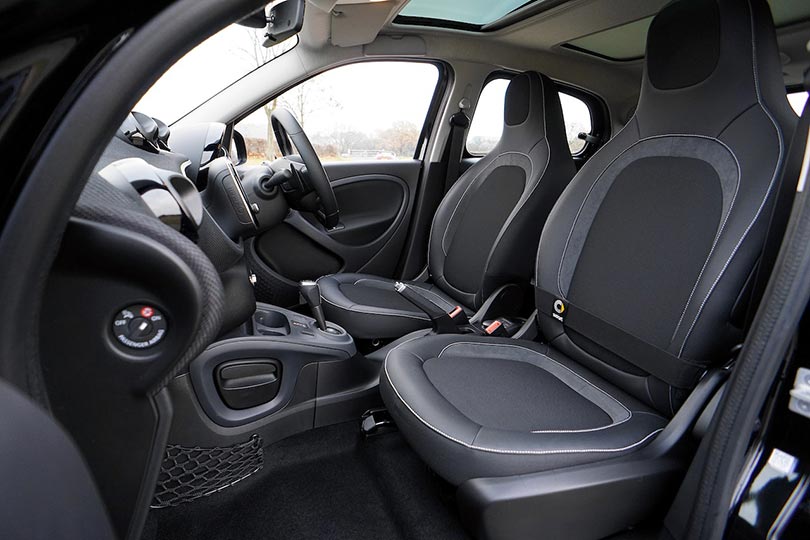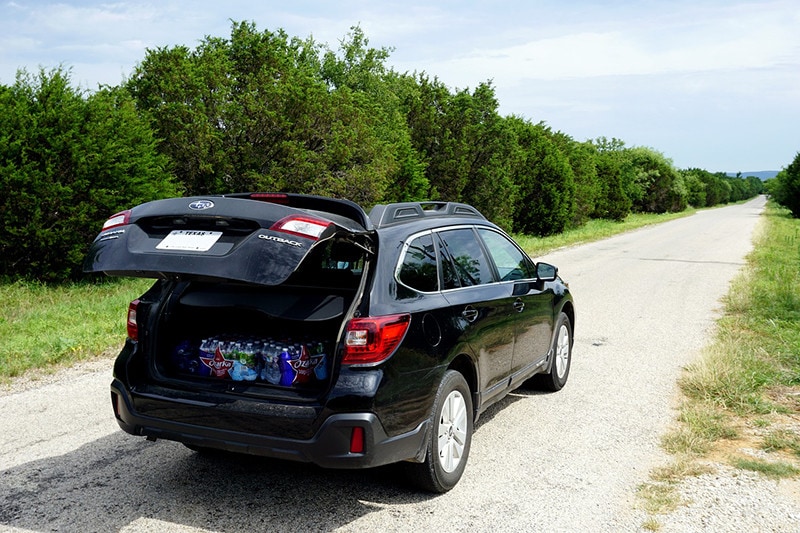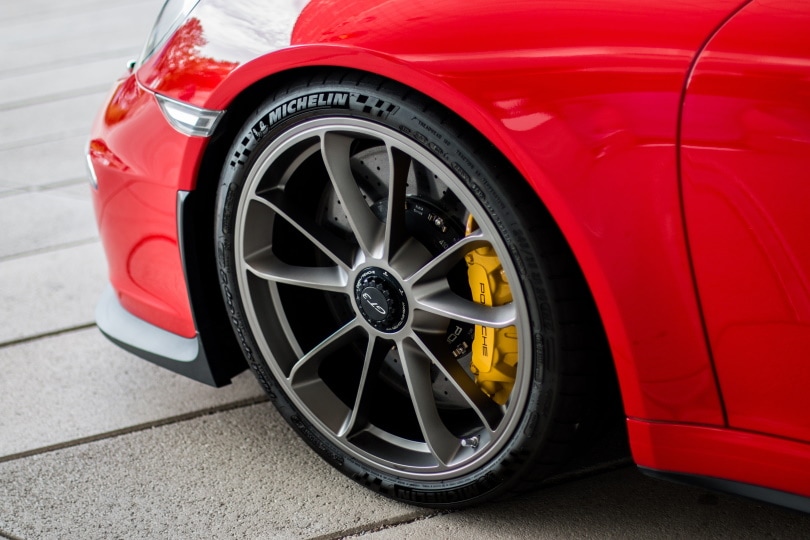How to Soundproof a Car – 10 Simple Ways
-
Pete Ortiz
- Last updated:

The sound of a growling engine can be satisfying, but only if you’re driving in the wilderness. When going to work or returning home from the grocery store, we want peace and quiet. Now, most modern-day vehicles have at least some sort of noise-dampening features in place. However, if you’re driving a truck, full-size SUV, or just an older car, chances are, it won’t be properly insulated.
So, what can you do in such a scenario? We’ve got good news: there are lots of ways to soundproof a vehicle without paying an auto shop or buying expensive panels. To help you tame a roaring motor and enjoy a noise-free ride, we made a list of the most effective (and efficient) sound insulating techniques. Check them out!
The 10 Simplest Ways to Soundproof Your Car
1. Use Sound-Dampening Floor Mats

Before you check the doors or the tires, make sure the floor is treated properly. It “sits” very close to the tires and the road and lets outdoor sounds in. But, there’s a quick and effective solution for that: mats/foam shields. They come in all shapes and sizes and block that noise. Foil, butyl rubber, and styrene-butadiene rubber are some of the best materials for keeping outside noises out.
Even if you’re on a tight budget, don’t buy low-quality insulating products. Car floors aren’t that thick, which is why dampening is so important. Using sound-canceling mats is easy. All you have to do is place them right between the floor and the regular mats that collect all the dirt and mush. You might have to cut them to match the floor. Cover both the front and the rear foot-wells and the cargo area (like in a van).
2. Don’t Forget About the Undercarriage!
Floor mats cancel most of the noise coming from the ground. However, if you’re still bothered by random rattling and roaring clamor, treating the undercarriage will fix that. There’s a wide range of protective undercoating products that are specifically formulated for this task. Now, most sedans, crossovers, and SUVs do get a layer of undercoating before hitting the dealerships.
But, it does lose its efficiency over time, especially if you live in an extremely cold or hot and humid area. Undercoating can be applied with a spray gun, roller, or brush. It will not only kill road noise but also protect the car’s bottom from salt, mud, and debris and serve as a thermal insulator. Use viscoelastic polymer, wax, or asphalt-based product(s).
3. Soundproof the Doors

Car doors are rather thin and provide poor protection against noise. So, our goal here is to create a tight seal between the doors and the vehicle’s body. If this is your first time doing this, opt for noise-dampening products with adhesive backing, as they’re easier to use. This will still take some effort, though. First, unscrew the interior panels of the doors.
Next, measure them and cut the insulation to match the panels in size. When installing the foil/rubber/foam, be very careful not to damage the locks, window regulators, latches, and actuators. Oh, and do remove the old rubber seals first! As for the materials, you can go with whatever you picked for the mats or invest in EPE/polyethylene foam.
4. Move on to the Roof
Just like the floor, the roof is quite large yet very bad at dampening outside sounds (mostly the wind, rain, and hail). Decent-quality insulation material will not only be able to soundproof it but also keep the precious warm air in during cold days and save you from the heat when it’s hot outside.
As long as the material has a sticky side, it shouldn’t be that hard to glue it up there. Go ahead and remove the hangers, cloth headliner, and lights. To ensure a strong “bond”, clean the roof with a water-soap mix or rubbing alcohol. Finally, measure the roof and cut the insulating product to size.
5. The Trunk Comes Next

Depending on how big the cargo apartment in your car is, soundproofing it can have a game-changing effect. Synthetic rubber foam will be great for treating the luggage compartment. Again, measure it first, cut the material to match it in size, and only then stick it to the insides of the trunk. If there’s carpeting on the floor of the trunk, remove it carefully.
6. Bonnet Deadening for the Engine
If you’re driving a diesel-powered vehicle, you should definitely soundproof the bonnet (AK the hood). Engines generate a lot of noise and since there’s little to no insulation under the hood, it goes directly into the cabin of the car. On the bright side, all it takes to fix this is a foam mat. Start by cleaning the surface with a water-soap mix to allow the foam to stick properly.
It would be best if the sound-dampening was heat-resistant (most of them are) and coated. Once the material is in place, do a test drive around the block and keep your eyes on the engine temps. Sometimes, when the insulator is poorly glued to the hood, it falls into the engine compartment, causing all kinds of trouble.
7. Switch to Narrow, High-Profile Tires

What do the tires have to do with anything? Well, most of the vibrations generated by any car come from the tires touching the ground. And, when they’re worn out, cracked, or of the wrong size, you’ll definitely feel all of that in the driver’s seat and the back. So, how do you know which tires to pick to minimize the noise? Here’s a quick, yet detailed guide:
- The size. Are you a fan of low-pro tires? True, they have a strong grip on the road and bring the car to a full stop faster. However, they’re NOT noise-free. A low-tire profile has a 50/50 profile, meaning there’s a lot less sidewall than on a regular tire. And while that does look pretty cool, there will be very little insulation there. The more rubber, the better, as it will absorb most of the noise.
- The width. For off-roading and rock climbing, wide tires are the way to go, because, again, they have a tighter grip. As you can imagine, large tires will transfer more vibration into the cabin. Narrow wheels might take some getting used to, but you’ll instantly see (or, rather, hear) the positive changes.
- The noise rating. These days, most market-leading manufacturers add a noise rating to their tires. First, there’s a decibel rating (the higher it is, the noisier they are). Next, if you see three waves on the tires, skip them, as that equals above-average noise levels; instead, invest in one-wave tires.
8. The Wipers: Hidden Troublemakers
Alright, with the interior and the tires insulated, let’s check on the wipers. If you’re driving an older vehicle, the wipers are probably big, bulky, and make lots of noise when they’re pushed to their limit. This is especially true when pushing through heavy rain or hail. Here’s what you can do to fix that:
- Clean the blades with a water-soap mix and a towel. Do this at least once a month for the best results (it will only take 5–10 minutes).
- The same goes for the windshield. Be a bit more gentle with it so that you don’t damage the glass.
- Check how tight the wipers are. Over time, they get loose. Be careful not to over-tighten them, though.
- The problem might be with the rubber parts. All that sunlight, rain, and dust make them “rough on the edges”. Rubbing alcohol is the remedy here.
- Most drivers don’t know this, but low wiper fluid levels can also be an issue. If the levels are, indeed, low, a refill is in order.
- If you have windshield protection installed, the wiper blades could be rubbing against it. Try removing it.
9. Soundproofing Sprays: Worth It or Not?

The short answer is yes, sound-dampening sprays are quite effective at keeping outside noises out. First, they are very easy to use. All you’ll have to do is buy the spray (it usually comes in an aerosol can), prepare the surface (make sure it’s clean), point the can, and fire away. One of the best things about soundproofing sprays is their ability to cover hard-to-reach spots.
This is important: a spray won’t be able to properly soundproof an entire car. For the best results, only use it once you’ve insulated the doors, floor, trunk, and roof. When working with floor mats, focus on covering the larger areas. The spray, in turn, will be able to fill all the gaps.
10. Remove Objects from Car
You’ll be surprised by how much noise moving objects make. We’re talking about coffee cups, keys, a phone, or a lighter. When driving on rough terrain, all these items will jump up and down and disturb your peace. Even if you mostly stick to polished city streets and highways, they’ll still be a problem because of the vibrations created by the engine.
Usually, an insulated trunk and floor should prevent the vibration from creating a fuss. That’s because noise-dampening materials are great at absorbing most of the sound waves and stopping them from reverberating and bouncing back into our ears. That’s how sound control works!
Can You Soundproof a Car Manually?

At first, it might seem like you need a professional mechanic to handle the process. However, once you get into it, you’ll see that unscrewing the panels, removing cloth headliners, and replacing the factory tires can be done with minimal effort. It all comes down to having the right tools for the job (a pair of gloves, screwdriver, sharp cutting knife, impact wrench) and finding the perfect sound-deadening materials.
In contrast to the vehicles from the 20th century, modern-day cars are a lot less complicated. Be careful, double-check everything before you do any cutting, and always buy more insulation than you think you need for this DIY project. Otherwise, you’ll run out of it in the blink of an eye. And remember: the floor and the trunk are the easiest parts to work with. So, begin by installing a couple of floor mats, and go from there!
What’s the Best Sound-Dampening Material?
How long does car insulation work? That’s one of the most common questions online. This largely depends on the material, of course. For example, noise-deadening sprays have an average lifespan of 25–30 years. Mineral wool, in turn, can last for up to 30–40 years. Acoustic caulk, vinyl (mass loaded), polymer, and fiberglass will be worth the investment as well, along with crumb rubber, butyl rubber, and cellulose.
As for the brands, Dynamat and Damplifier are leading the market right now. They are a bit too expensive for most drivers, though. So, instead of focusing on the manufacturer, you can just pick one of the materials that we just listed and stick with it. A quick note: most insulating materials are universal; you can use the “leftovers” to soundproof a room or your garage, basement, or barn.
Where Does All the Noise Come From?
Noise/sound is airborne. It’s capable of traveling through the tiniest cracks/openings in your car. This can be the sound of heavy traffic, sirens in the background, rain, wind, or faraway sounds from a stadium or a construction site. All these noises will find a way into the cabin when you’re standing idle. Once you hit the road, get ready for the potholes, rocks, and muddy trails to make extra noise.
But what if you drive away from all the traffic and stick to polished roads? There will still be lots of noise because even the most advanced cars aren’t exactly silent. The brakes squeal while the suspension clunks and the tires screech. And then there are parts that vibrate and rumble. As for the engine and the exhaust, a proper air intake can take care of that. It won’t protect you from any other noises, though.
 Conclusion
Conclusion
Sound insulation in a car doesn’t have to be expensive. Over the decades, engineers, scientists, and acoustic experts have come up with proven-to-work, affordable ways to reduce noise levels. And the best techniques for ensuring a quiet, comfortable commute are very straightforward and easy on the wallet. The most important thing here is to start.
You absolutely don’t have to do the whole thing at once. Even if you only replace the seals or insulate the doors in the car, the difference in noise levels will be quite big. Soundproofing the roof, in turn, will have an even bigger impact. Go slow, use our tips and tricks as your guide, and gain confidence as you get things done!
- iKoustic – Science Of Soundproofing
- Soundproofing Your Car: Everything You Need to Know
- EPE Foam: Properties, Uses, and Methods of Recycling
- Which Types of Insulation Help Reduce Noise?
- My Car Has Undercarriage Damage — What Now?
- Reduce Noise With Sound-Proofing Insulation
- Can You Compress Mineral Wool Insulation?
- Soundproof Spray Foam Insulation Costs
- What Are Low-Profile Tires Used For?
- Here’s How to Soundproof Your Vehicle
- How to Fix Noisy Windshield Wipers In Minutes – Easy DIY!
- How To Soundproof A Vehicle – Step by Step DIY Guide
Featured Image Credit: PIX1861, Pixabay
Contents


